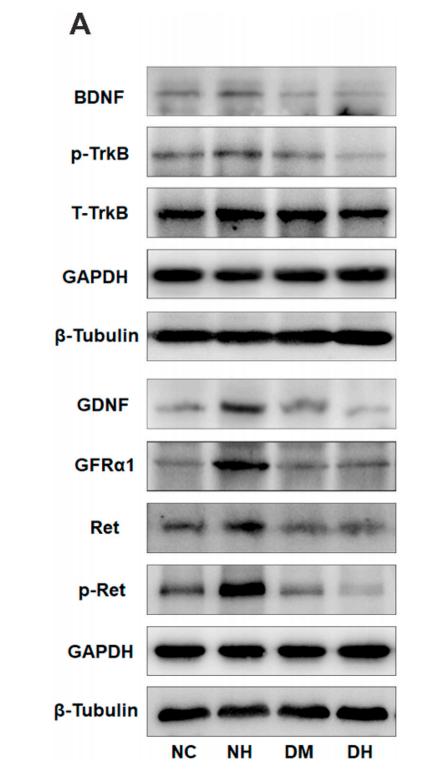GDNF Antibody - #DF7727
| Product: | GDNF Antibody |
| Catalog: | DF7727 |
| Description: | Rabbit polyclonal antibody to GDNF |
| Application: | WB |
| Reactivity: | Human, Mouse |
| Prediction: | Pig, Bovine, Horse, Sheep, Rabbit, Dog, Chicken |
| Mol.Wt.: | 24 kDa; 24kD(Calculated). |
| Uniprot: | P39905 |
| RRID: | AB_2841195 |
Related Downloads
Protocols
Product Info
*The optimal dilutions should be determined by the end user.
*Tips:
WB: For western blot detection of denatured protein samples. IHC: For immunohistochemical detection of paraffin sections (IHC-p) or frozen sections (IHC-f) of tissue samples. IF/ICC: For immunofluorescence detection of cell samples. ELISA(peptide): For ELISA detection of antigenic peptide.
Cite Format: Affinity Biosciences Cat# DF7727, RRID:AB_2841195.
Fold/Unfold
Astrocyte derived trophic factor; Astrocyte derived trophic factor 1; Astrocyte-derived trophic factor; ATF 1; ATF 2; Atf; ATF1; ATF2; gdnf; GDNF_HUMAN; Glial cell derived neurotrophic factor; Glial Cell Line Derived Neurotrophic Factor; Glial cell line-derived neurotrophic factor; Glial derived neurotrophic factor; HFB1 GDNF; hGDNF; HSCR3;
Immunogens
In the brain, predominantly expressed in the striatum with highest levels in the caudate and lowest in the putamen. Isoform 2 is absent from most tissues except for low levels in intestine and kidney. Highest expression of isoform 3 is found in pancreatic islets. Isoform 5 is expressed at very low levels in putamen, nucleus accumbens, prefrontal cortex, amygdala, hypothalamus and intestine. Isoform 3 is up-regulated in the middle temporal gyrus of Alzheimer disease patients while isoform 2 shows no change.
- P39905 GDNF_HUMAN:
- Protein BLAST With
- NCBI/
- ExPASy/
- Uniprot
MKLWDVVAVCLVLLHTASAFPLPAGKRPPEAPAEDRSLGRRRAPFALSSDSNMPEDYPDQFDDVMDFIQATIKRLKRSPDKQMAVLPRRERNRQAAAANPENSRGKGRRGQRGKNRGCVLTAIHLNVTDLGLGYETKEELIFRYCSGSCDAAETTYDKILKNLSRNRRLVSDKVGQACCRPIAFDDDLSFLDDNLVYHILRKHSAKRCGCI
Predictions
Score>80(red) has high confidence and is suggested to be used for WB detection. *The prediction model is mainly based on the alignment of immunogen sequences, the results are for reference only, not as the basis of quality assurance.
High(score>80) Medium(80>score>50) Low(score<50) No confidence
PTMs - P39905 As Substrate
| Site | PTM Type | Enzyme | Source |
|---|---|---|---|
| N126 | N-Glycosylation | Uniprot | |
| S146 | Phosphorylation | Uniprot | |
| S148 | Phosphorylation | Uniprot | |
| T154 | Phosphorylation | Uniprot | |
| T155 | Phosphorylation | Uniprot | |
| Y156 | Phosphorylation | Uniprot | |
| S164 | Phosphorylation | Uniprot |
Research Backgrounds
Neurotrophic factor that enhances survival and morphological differentiation of dopaminergic neurons and increases their high-affinity dopamine uptake.
Secreted.
In the brain, predominantly expressed in the striatum with highest levels in the caudate and lowest in the putamen. Isoform 2 is absent from most tissues except for low levels in intestine and kidney. Highest expression of isoform 3 is found in pancreatic islets. Isoform 5 is expressed at very low levels in putamen, nucleus accumbens, prefrontal cortex, amygdala, hypothalamus and intestine. Isoform 3 is up-regulated in the middle temporal gyrus of Alzheimer disease patients while isoform 2 shows no change.
Homodimer; disulfide-linked. Interacts with RET. Interacts (via propeptide) with SORL1 (via N-terminal ectodomain); this interaction affects GDNF-regulated, but not constitutive secretion. Also interacts with SORL1 in complex with GFRA1; this interaction leads to GDNF endocytosis and lysosomal degradation.
Belongs to the TGF-beta family. GDNF subfamily.
References
Application: WB Species: mice Sample: cortex tissue
Restrictive clause
Affinity Biosciences tests all products strictly. Citations are provided as a resource for additional applications that have not been validated by Affinity Biosciences. Please choose the appropriate format for each application and consult Materials and Methods sections for additional details about the use of any product in these publications.
For Research Use Only.
Not for use in diagnostic or therapeutic procedures. Not for resale. Not for distribution without written consent. Affinity Biosciences will not be held responsible for patent infringement or other violations that may occur with the use of our products. Affinity Biosciences, Affinity Biosciences Logo and all other trademarks are the property of Affinity Biosciences LTD.

